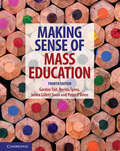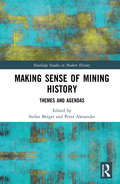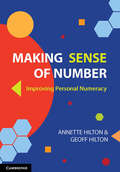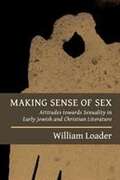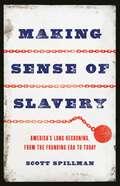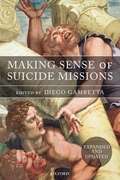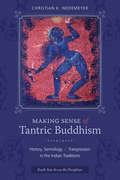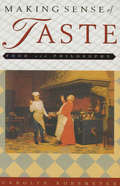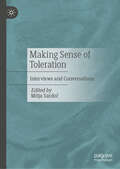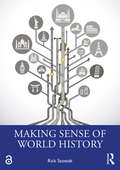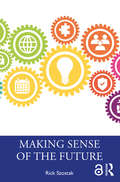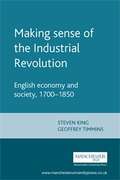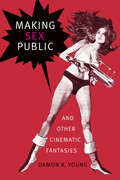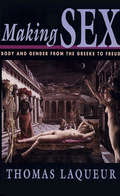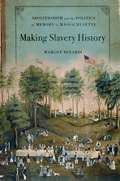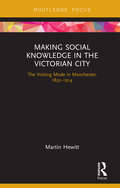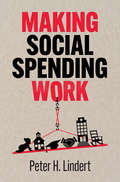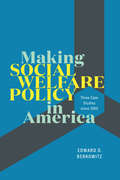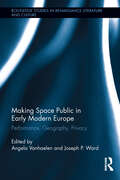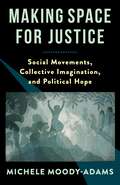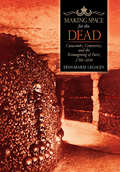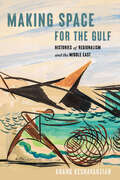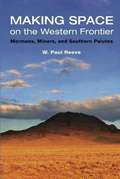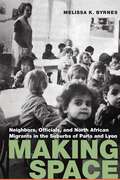- Table View
- List View
Making Sense of Mass Education
by Gordon TaitMaking Sense of Mass Education provides an engaging and accessible analysis of traditional issues associated with mass education. The book challenges preconceptions about social class, gender and ethnicity discrimination; highlights the interplay between technology, media, popular culture and schooling; and inspects the relevance of ethics and philosophy in the modern classroom. The third edition has been comprehensively updated to include the latest research, statistics and legal policies. Each chapter challenges and breaks down common myths surrounding each topic, encouraging pre-service teachers to think critically and reflect on their own beliefs. The inclusion of a new chapter on alternative education reflects the ever-changing Australian educational landscape. In Making Sense of Mass Education, Gordon Tait expertly blurs disciplinary boundaries, drawing on sociology, cultural studies, history, philosophy, ethics and jurisprudence to provide a comprehensive understanding of the fundamental concepts of mass education.
Making Sense of Mass Education
by Gordon Tait Peter O'Brien Nerida Spina Jenna Gillett-SwanMaking Sense of Mass Education provides a contemporary analysis of the ideas and issues that have traditionally dominated education research, challenging outdated preconceptions with fundamental theory and discussion. It takes a demythologising approach in assessing these issues and their relevance to schooling and education in Australia. This text examines the cultural context of education and the influence of external media and new technologies, and highlights the many forms of discrimination in education, including social class, race and gender. It looks at alternative approaches to education, including the repercussions of gathering data to measure school performance, and considers the intersection of ethics and philosophy in classroom teaching. The fourth edition expands on these issues with three new chapters: on sexuality, children's rights, and neoliberalism and the marketisation of education. Each chapter challenges and breaks down common myths surrounding these topics, encouraging pre-service teachers to think critically and reflect on their own beliefs.
Making Sense of Mining History: Themes and Agendas (Routledge Studies in Modern History)
by Stefan Berger Peter AlexanderThis book draws together international contributors to analyse a wide range of aspects of mining history across the globe including mining archaeology, technologies of mining, migration and mining, the everyday life of the miner, the state and mining, industrial relations in mining, gender and mining, environment and mining, mining accidents, the visual history of mining, and mining heritage. The result is a counter balance to more common national and regional case study perspectives.
Making Sense of Number: Improving Personal Numeracy
by Annette Hilton Geoff HiltonMaking Sense of Number is a concise introduction to personal and professional numeracy skills, helping readers to become more mathematically competent. It includes relevant content to assist pre-service teachers to improve numeracy for the classroom or to prepare for LANTITE, as well as support for practising teachers to develop their understanding and skills in numeracy. Making Sense of Number focuses on number sense as a conceptual framework for understanding mathematics, covering foundational areas of mathematics that often cause concern such as multiplication, fractions, ratio, rate and scale. The authors use real-world examples to explain mathematical concepts in an accessible and engaging way. Written by authors with over 30 years' experience teaching mathematics at primary, secondary and tertiary levels, Making Sense of Number is an essential guide for both pre-service teachers and those looking to improve their understanding of numeracy.
Making Sense of Sex: Attitudes Towards Sexuality in Early Jewish and Christian Literature
by William LoaderThis book is about listening to what writers were saying about sex in early Judaism and Christianity -- ancient words surprisingly relevant for today. It functions as both a summary and a conclusion to William Loader's five previous books on sexuality in a form accessible to those who may not have a background knowledge of early Judaism and Christianity. It also contains a useful subject index to those five previous volumes. <p><p> In examining thoroughly all the relevant writings and related evidence of the Greco-Roman period, Loader dialogues with scholarship related to each writing in order to make his conclusions as objective as possible. By enabling the reader to listen respectfully to these ancient texts, Making Sense of Sex provides a basis for informed discussion of sexual issues today.
Making Sense of Slavery: America's Long Reckoning, from the Founding Era to Today
by Scott SpillmanAn &“essential&” (James Oakes, author of The Crooked Path to Abolition) history of the study of slavery in America, from the Revolutionary era to the 1619 Project, showing how these intellectual debates have shaped American public life In recent years, from school board meetings to the halls of Congress, Americans have engaged in fierce debates about how slavery and its legacies ought to be taught, researched, and narrated. But since the earliest days of the Republic, political leaders, abolitionists, judges, scholars, and ordinary citizens have all struggled to explain and understand the peculiar institution. In Making Sense of Slavery, historian Scott Spillman shows that the study of slavery was a vital catalyst for the broader development of American intellectual life and politics. In contexts ranging from the plantation fields to the university classroom, Americans interpreted slavery and its afterlives through many lenses, shaping the trajectory of disciplines from economics to sociology, from psychology to history. Spillman delves deeply into the archives, and into the pathbreaking work of scholars such as W. E. B. Du Bois and Annette Gordon-Reed, to trace how generations of Americans have wrestled with the paradox of slavery in a country founded on principles of liberty and equality. As the debate over the place of slavery in our history rages on, Making Sense of Slavery shows that what is truly central to American history is this very debate itself.
Making Sense of Suicide Missions
by Diego GambettaBased on a wealth of original information and research, and containing contributions from internationally distinguished scholars, 'Making Sense of Suicide Missions' furthers our understanding of this chilling feature of the contemporary world in radically new and unexpected ways.
Making Sense of Tantric Buddhism: History, Semiology, and Transgression in the Indian Traditions (South Asia Across the Disciplines)
by Christian WedemeyerMaking Sense of Tantric Buddhism fundamentally rethinks the nature of the transgressive theories and practices of the Buddhist Tantric traditions, challenging the notion that the Tantras were "marginal" or primitive and situating them instead—both ideologically and institutionally—within larger trends in mainstream Buddhist and Indian culture.Critically surveying prior scholarship, Wedemeyer exposes the fallacies of attributing Tantric transgression to either the passions of lusty monks, primitive tribal rites, or slavish imitation of Saiva traditions. Through comparative analysis of modern historical narratives—that depict Tantrism as a degenerate form of Buddhism, a primal religious undercurrent, or medieval ritualism—he likewise demonstrates these to be stock patterns in the European historical imagination.Through close analysis of primary sources, Wedemeyer reveals the lived world of Tantric Buddhism as largely continuous with the Indian religious mainstream and deploys contemporary methods of semiotic and structural analysis to make sense of its seemingly repellent and immoral injunctions. Innovative, semiological readings of the influential Guhyasamaja Tantra underscore the text's overriding concern with purity, pollution, and transcendent insight—issues shared by all Indic religions—and a large-scale, quantitative study of Tantric literature shows its radical antinomianism to be a highly managed ritual observance restricted to a sacerdotal elite. These insights into Tantric scripture and ritual clarify the continuities between South Asian Tantrism and broader currents in Indian religion, illustrating how thoroughly these "radical" communities were integrated into the intellectual, institutional, and social structures of South Asian Buddhism.
Making Sense of Taste: Food and Philosophy
by Carolyn KorsmeyerTaste, perhaps the most intimate of the five senses, has traditionally been considered beneath the concern of philosophy, too bound to the body, too personal and idiosyncratic. Yet, in addition to providing physical pleasure, eating and drinking bear symbolic and aesthetic value in human experience, and they continually inspire writers and artists.In Making Sense of Taste, Carolyn Korsmeyer explains how taste came to occupy so low a place in the hierarchy of senses and why it is deserving of greater philosophical respect and attention. Korsmeyer begins with the Greek thinkers who classified taste as an inferior, bodily sense; she then traces the parallels between notions of aesthetic and gustatory taste that were explored in the formation of modern aesthetic theories. She presents scientific views of how taste actually works and identifies multiple components of taste experiences.Turning to taste's objects—food and drink—she looks at the different meanings they convey in art and literature as well as in ordinary human life and proposes an approach to the aesthetic value of taste that recognizes the representational and expressive roles of food. Korsmeyer's consideration of art encompasses works that employ food in contexts sacred and profane, that seek to whet the appetite and to keep it at bay; her selection of literary vignettes ranges from narratives of macabre devouring to stories of communities forged by shared eating.
Making Sense of Toleration: Interviews and Conversations
by Mitja SardočThis book brings together a collection of interviews and conversations with leading scholars across different disciplines and areas of research including moral and political philosophy, history, sociology, political theory, psychology, and jurisprudence, among others. It provides an authoritative presentation of contemporary accounts of toleration, their conceptual foundations, and a comprehensive presentation of the different concepts most commonly associated with it (e.g. civility, dignity, coercion, harm, conflict, disagreement, secularism, power, domination, trust, non-interference, neutrality, fairness, pluralism, respect, recognition and ultimately diversity itself). The interviews and conversations published in this volume address some of the most pressing controversies on toleration (and related issues) at both the theoretical and practical levels. Alongside customary refinements of arguments and positions usually embedded in academic conversations, these interviews provide unique insights into the ‘behind the scenes’ on one of the central topics in contemporary scholarly research.
Making Sense of World History
by Rick SzostakMaking Sense of World History is a comprehensive and accessible textbook that helps students understand the key themes of world history within a chronological framework stretching from ancient times to the present day. To lend coherence to its narrative, the book employs a set of organizing devices that connect times, places, and/or themes. This narrative is supported by: Flowcharts that show how phenomena within diverse broad themes interact in generating key processes and events in world history. A discussion of the common challenges faced by different types of agent, including rulers, merchants, farmers, and parents, and a comparison of how these challenges were addressed in different times and places. An exhaustive and balanced treatment of themes such as culture, politics, and economy, with an emphasis on interaction. Explicit attention to skill acquisition in organizing information, cultural sensitivity, comparison, visual literacy, integration, interrogating primary sources, and critical thinking. A focus on historical “episodes” that are carefully related to each other. Through the use of such devices, the book shows the cumulative effect of thematic interactions through time, communicates the many ways in which societies have influenced each other through history, and allows us to compare and contrast how they have reacted to similar challenges. They also allow the reader to transcend historical controversies and can be used to stimulate class discussions and guide student assignments. With a unified authorial voice and offering a narrative from the ancient to the present, this is the go-to textbook for World History courses and students. The Open Access version of this book, available at https://www.taylorfrancis.com/books/9781003013518, has been made available under a Creative Commons Attribution-Non Commercial-No Derivatives 4.0 license.
Making Sense of the Future
by Rick SzostakMaking Sense of the Future integrates the latest thinking in Future Studies with the author’s expertise in world history, economics, interdisciplinary studies, knowledge organization, and political activism. The book takes a systems approach that recognizes the complexity of our world. It begins by suggesting a set of goals for human societies and identifying innovative strategies for achieving these goals that could gain broad support. Each chapter begins with a “How to” section that discusses how we can identify goals, strategies, trends, surprises, or implementation strategies and concludes with an integrative analysis that draws connections across the preceding discussions. Taking a cross-disciplinary approach, Szostak explores key trends and how these interact so that he can develop strategies to guide trends towards desirable futures. He discusses the ways in which we can best prepare for surprises such as epidemics and natural disasters, enabling us to react to them in beneficial ways. Supported by a list of guiding questions and suggestions for class projects, this is an accessible textbook for students of Future Studies and Future Studies courses.
Making Sense of the Industrial Revolution
by Steven King Geoffrey TimminsPresents a new perspective on the Industrial Revolution providing far more than just an account of industrial change. Looks at the development of the economic structures and includes chapters on financing the revolution, technological change, markets and demand, transport and food. The final section looks at economic change and its impact and includes chapters on demography, the household, families, authority and regulation, and the built environment. Providing a complete summary of the various debates in the literature on this period, making a strong case for re-introducing a regional approach to the history of the age.
Making Sex Public and Other Cinematic Fantasies (Theory Q)
by Damon R. YoungBeginning in the late 1950s, representations of and narratives about sex proliferated on French and U.S. movie screens. Cinema began to display forms of sexuality that were no longer strictly associated with domesticity nor limited to heterosexual relations between loving couples. Women’s bodies and queer sexualities became intensely charged figures of political contestation, aspiration, and allegory, central to new ways of imagining sexuality and to new liberal understandings of individual freedom and social responsibility. In Making Sex Public Damon R. Young tracks the emergence of two conflicting narratives: on the one hand, a new model of sex as harmoniously integrated into civic existence; on the other, an idea of women’s and queer sexuality as corrosive to the very fabric of social life. Taking a transatlantic perspective from the late '50s through the present, from And God Created Woman and Barbarella to Cruising and Shortbus, Young argues that cinema participated in the transformation of the sexual subject while showing how women and queers were both agents and objects of that transformation.
Making Sex: Body and Gender from the Greeks to Freud
by Thomas LaqueurThis is a book about the making and unmaking of sex over the centuries. It tells the astonishing story of sex in the West from the ancients to the moderns in a precise account of developments in reproductive anatomy and physiology. We cannot fail to recognize the players in Thomas Laqueur’s story—the human sexual organs and pleasures, food, blood, semen, egg, sperm—but we will be amazed at the plots into which they have been woven by scientists, political activists, literary figures, and theorists of every stripe. <P><P> Laqueur begins with the question of why, in the late eighteenth century, woman’s orgasm came to be regarded as irrelevant to conception, and he then proceeds to retrace the dramatic changes in Western views of sexual characteristics over two millennia. Along the way, two “masterplots” emerge. In the one-sex story, woman is an imperfect version of man, and her anatomy and physiology are construed accordingly: the vagina is seen as an interior penis, the womb as a scrotum, the ovaries as testicles. The body is thus a representation, not the foundation, of social gender. The second plot tends to dominate post-Enlightenment thinking while the one-sex model is firmly rooted in classical learning. The two-sex story says that the body determines gender differences, that woman is the opposite of man with incommensurably different organs, functions, and feelings. The two plots overlap; neither ever holds a monopoly. Science may establish many new facts, but even so, Laqueur argues, science was only providing a new way of speaking, a rhetoric and not a key to female liberation or to social progress. Making Sex ends with Freud, who denied the neurological evidence to insist that, as a girl becomes a woman, the locus of her sexual pleasure shifts from the clitoris to the vagina; she becomes what culture demands despite, not because of, the body. Turning Freud’s famous dictum around, Laqueur posits that destiny is anatomy. Sex, in other words, is an artifice. <P><P> This is a powerful story, written with verve and a keen sense of telling detail (be it technically rigorous or scabrously fanciful). Making Sex will stimulate thought, whether argument or surprised agreement, in a wide range of readers.
Making Slavery History: Abolitionism and the Politics of Memory in Massachusetts
by Margot MinardiMaking Slavery History focuses on how commemorative practices and historical arguments about the American Revolution set the course for antislavery politics in the nineteenth century. The particular setting is a time and place in which people were hyperconscious of their roles as historical actors and narrators: Massachusetts in the period between the Revolution and the Civil War. This book shows how local abolitionists, both black and white, drew on their state's Revolutionary heritage to mobilize public opposition to Southern slavery. When it came to securing the citizenship of free people of color within the Commonwealth, though, black and white abolitionists diverged in terms of how they idealized black historical agency. Although it is often claimed that slavery in New England is a history long concealed, Making Slavery History finds it hidden in plain sight. <p><p>From memories of Phillis Wheatley and Crispus Attucks to representations of black men at the Battle of Bunker Hill, evidence of the local history of slavery cropped up repeatedly in early national Massachusetts. In fixing attention on these seemingly marginal presences, this book demonstrates that slavery was unavoidably entangled in the commemorative culture of the early republic-even in a place that touted itself as the "cradle of liberty." Transcending the particular contexts of Massachusetts and the early American republic, this book is centrally concerned with the relationship between two ways of making history, through social and political transformation on the one hand and through commemoration, narration, and representation on the other. Making Slavery History examines the relationships between memory and social change, between histories of slavery and dreams of freedom, and between the stories we tell ourselves about who we have been and the possibilities we perceive for who we might become.
Making Social Knowledge in the Victorian City: The Visiting Mode in Manchester, 1832-1914
by Martin HewittThis study explores the ‘ecology of knowledge’ of urban Britain in the Victorian period and seeks to examine the way in which Victorians comprehended the nature of their urban society, through an exploration of the history of Victorian Manchester, and two specific case studies on the fiction of Elizabeth Gaskell and the campaigns for educational extension which emerged out of the city. It argues that crucial to the Victorians’ approaches was the ‘visiting mode’ as a particular discursive formation, including its institutional foundations, its characteristic modes and assumptions, and the texts which exemplify it. Recognition of the importance of the visiting mode, it is argued, offers a fundamental challenge to established Foucauldian interpretations of nineteenthcentury society and culture and provides an important corrective to recent scholarship of nineteenth-century technologies of knowing.
Making Social Spending Work
by Peter H. LindertHow does social spending relate to economic growth and which countries have got this right and wrong? Peter Lindert examines the experience of countries across the globe to reveal what has worked, what needs changing, and who the winners and losers are under different systems. He traces the development of public education, health care, pensions, and welfare provision, and addresses key questions around intergenerational inequality and fiscal redistribution, the returns to investment in human capital, how to deal with an aging population, whether migration is a cost or a benefit, and how social spending differs in autocracies and democracies. The book shows that what we need to do above all is to invest more in the young from cradle to career, and shift the burden of paying for social insurance away from the workplace and to society as a whole.
Making Social Welfare Policy in America: Three Case Studies since 1950
by Edward D. BerkowitzAmerican social welfare policy has produced a health system with skyrocketing costs, a disability insurance program that consigns many otherwise productive people to lives of inactivity, and a welfare program that attracts wide criticism. Making Social Welfare Policy in America explains how this happened by examining the historical development of three key programs—Social Security Disability Insurance, Medicare, and Temporary Aid to Needy Families. Edward D. Berkowitz traces the developments that led to each program’s creation. Policy makers often find it difficult to dislodge a program’s administrative structure, even as political, economic, and cultural circumstances change. Faced with this situation, they therefore solve contemporary problems with outdated programs and must improvise politically acceptable solutions. The results vary according to the political popularity of the program and the changes in the conventional wisdom. Some programs, such as Social Security Disability Insurance, remain in place over time. Policy makers have added new parts to Medicare to reflect modern developments. Congress has abolished Aid to Families of Dependent Children and replaced with a new program intended to encourage work among adult welfare recipients raising young children. Written in an accessible style and using a minimum of academic jargon, this book illuminates how three of our most important social welfare programs have come into existence and how they have fared over time.
Making Space Public in Early Modern Europe: Performance, Geography, Privacy (Routledge Studies in Renaissance Literature and Culture #Vol. 23)
by Joseph P. Ward Angela VanhaelenBroadening the conversation begun in Making Publics in Early Modern Europe (2009), this book examines how the spatial dynamics of public making changed the shape of early modern society. The publics visited in this volume are voluntary groupings of diverse individuals that could coalesce through the performative uptake of shared cultural forms and practices. The contributors argue that such forms of association were social productions of space as well as collective identities. Chapters explore a range of cultural activities such as theatre performances; travel and migration; practices of persuasion; the embodied experiences of lived space; and the central importance of media and material things in the creation of publics and the production of spaces. They assess a multiplicity of publics that produced and occupied a multiplicity of social spaces where collective identity and voice could be created, discovered, asserted, and exercised. Cultural producers and consumers thus challenged dominant ideas about just who could enter the public arena, greatly expanding both the real and imaginary spaces of public life to include hitherto excluded groups of private people. The consequences of this historical reconfiguration of public space remain relevant, especially for contemporary efforts to meaningfully include the views of ordinary people in public life.
Making Space for Justice: Social Movements, Collective Imagination, and Political Hope
by Michele Moody-AdamsFrom nineteenth-century abolitionism to Black Lives Matter today, progressive social movements have been at the forefront of social change. Yet it is seldom recognized that such movements have not only engaged in political action but also posed crucial philosophical questions about the meaning of justice and about how the demands of justice can be met.Michele Moody-Adams argues that anyone who is concerned with the theory or the practice of justice—or both—must ask what can be learned from social movements. Drawing on a range of compelling examples, she explores what they have shown about the nature of justice as well as what it takes to create space for justice in the world. Moody-Adams considers progressive social movements as wellsprings of moral inquiry and as agents of social change, drawing out key philosophical and practical principles. Social justice demands humane regard for others, combining compassionate concern and robust respect. Successful movements have drawn on the transformative power of imagination, strengthening the motivation to pursue justice and to create the political institutions and social policies that can sustain it by inspiring political hope.Making Space for Justice contends that the insights arising from social movements are critical to bridging the gap between discerning theory and effective practice—and should be transformative for political thought as well as for political activism.
Making Space for the Dead: Catacombs, Cemeteries, and the Reimagining of Paris, 1780–1830
by Erin-Marie LegaceyThe dead of Paris, before the French Revolution, were most often consigned to mass graveyards that contemporaries described as terrible and terrifying, emitting "putrid miasmas" that were a threat to both health and dignity. In a book that is at once wonderfully macabre and exceptionally informative, Erin-Marie Legacey explores how a new burial culture emerged in Paris as a result of both revolutionary fervor and public health concerns, resulting in the construction of park-like cemeteries on the outskirts of the city and a vast underground ossuary. Making Space for the Dead describes how revolutionaries placed the dead at the center of their republican project of radical reinvention of French society and envisioned a future where graveyards would do more than safely contain human remains; they would serve to educate and inspire the living. Legacey unearths the unexpectedly lively process by which burial sites were reimagined, built, and used, focusing on three of the most important of these new spaces: the Paris Catacombs, Père Lachaise cemetery, and the short-lived Museum of French Monuments. By situating discussions of death and memory in the nation's broader cultural and political context, as well as highlighting how ordinary Parisians understood and experienced these sites, she shows how the treatment of the dead became central to the reconstruction of Parisian society after the Revolution.
Making Space for the Gulf: Histories of Regionalism and the Middle East (Worlding the Middle East)
by Arang KeshavarzianThe Persian Gulf has long been a contested space—an object of imperial ambitions, national antagonisms, and migratory dreams. The roots of these contestations lie in the different ways the Gulf has been defined as a region, both by those who live there and those beyond its shore. Making Space for the Gulf reveals how capitalism, empire-building, geopolitics, and urbanism have each shaped understandings of the region over the last two centuries. Here, the Gulf comes into view as a created space, encompassing dynamic social relations and competing interests. Arang Keshavarzian writes a new history of the region that places Iran, Iraq, and the Arabian Peninsula together within global processes. He connects moments more often treated as ruptures—the discovery of oil, the Iranian Revolution, the rise and decline of British empire, the emergence of American power—and crafts a narrative populated by a diverse range of people—migrants and ruling families, pearl-divers and star architects, striking taxi drivers and dethroned rulers, protectors of British India and stewards of globalized American universities. Tacking across geographic scales, Keshavarzian reveals how the Gulf has been globalized through transnational relations, regionalized as a geopolitical category, and cleaved along national divisions and social inequalities. When understood as a process, not an object, the Persian Gulf reveals much about how regions and the world have been made in modern times. Making Space for the Gulf offers a fresh understanding of this globally consequential place.
Making Space on the Western Frontier: Mormons, Miners, and Southern Paiutes
by W. Paul ReeveWhen Mormon ranchers and Anglo-American miners moved into centuries-old Southern Paiute space during the last half of the nineteenth century, a clash of cultures quickly ensued. W. Paul Reeve explores the dynamic nature of that clash as each group attempted to create sacred space on the southern rim of the Great Basin according to three very different world views. With a promising discovery of silver at stake, the United States Congress intervened in an effort to shore up Nevada's mining frontier, while simultaneously addressing both the "Mormon Question" and the "Indian Problem." Even though federal officials redrew the Utah/Nevada/Arizona borders and created a reservation for the Southern Paiutes, the three groups continued to fashion their own space, independent of the new boundaries that attempted to keep them apart. When the dust on the southern rim of the Great Basin finally settled, a hierarchy of power emerged that disentangled the three groups according to prevailing standards of Americanism. As Reeve sees it, the frontier proved a bewildering mixing ground of peoples, places, and values that forced Mormons, miners, and Southern Paiutes to sort out their own identity and find new meaning in the mess.
Making Space: Neighbors, Officials, and North African Migrants in the Suburbs of Paris and Lyon (France Overseas: Studies in Empire and Decolonization)
by Melissa K. ByrnesSince the 2005 urban protests in France, public debate has often centered on questions of how the country has managed its relationship with its North African citizens and residents. In Making Space Melissa K. Byrnes considers how four French suburbs near Paris and Lyon reacted to rapidly growing populations of North Africans, especially Algerians before, during, and after the Algerian War. In particular, Byrnes investigates what motivated local actors such as municipal officials, regional authorities, employers, and others to become involved in debates over migrants&’ rights and welfare, and the wide variety of strategies community leaders developed in response to the migrants&’ presence. An examination of the ways local policies and attitudes formed and re-formed communities offers a deeper understanding of the decisions that led to the current tensions in French society and questions about France&’s ability—and will—to fulfill the promise of liberty, equality, and fraternity for all of its citizens. Byrnes uses local experiences to contradict a version of French migration history that reads the urban unrest of recent years as preordained.

